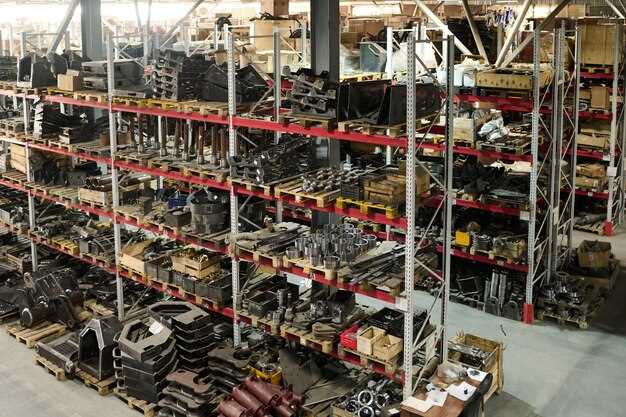
In any workshop or garage, efficient management of inventory is crucial for maximizing productivity and minimizing downtime. An organized parts storage system not only helps in tracking components but also enhances accessibility, making it easier for you to locate necessary items quickly. This is particularly important in busy environments where a single misplaced part can hinder progress on projects.
Establishing a well-structured storage system involves assessing your current inventory and identifying specific needs based on the types and volumes of parts you frequently use. By categorizing items according to usage, size, or function, you can create an efficient system that saves valuable time. Moreover, implementing a labeling system can further streamline the process, ensuring that each component has a designated spot and is easy to find.
As you embark on this organizational journey, consider investing in appropriate storage solutions such as bins, shelving, and pegboards that cater to your workshop’s unique requirements. An effective parts storage system not only fosters an organized workspace but also establishes a foundation for systematic inventory management that can grow with your shop.
Choosing the Right Parts Bin for Your Inventory Needs
Selecting the appropriate parts bin is critical for any organized inventory system. The right bin should cater to the specific needs of your shop while enhancing efficiency. Start by assessing the types of parts you handle. Are they large or small, heavy or lightweight? This evaluation will guide you in determining the size and material needed for your bins.
Consider the layout of your workspace. A well-planned inventory setup ensures easy access and retrieval of parts. Open bins are ideal for larger items, allowing visibility and quick access. Conversely, small parts often require compartmentalized bins or stackable options to maximize space. Using clear bins can also help in identifying contents without opening them, which saves time.
Another factor to consider is the durability of the parts bin. Heavy-duty plastic or metal bins might be necessary for rugged use, whereas lightweight plastic may suffice for lighter items. Additionally, check for features such as label holders or dividers that can help maintain order and facilitate quick identification of inventory.
Lastly, don’t overlook the importance of bin location in relation to your workflow. Keep the most frequently used items within easy reach while less common parts can be stored further away. This strategic placement will streamline your operations, contributing to a more efficient shop. Ultimately, investing time in choosing the right parts bin will pay off through improved organization and productivity.
Implementing a Labeling System to Enhance Accessibility

A well-organized parts storage system is crucial for efficiency in any shop. Implementing a labeling system can significantly enhance the accessibility of your parts stored in bins. Effective labels provide immediate visibility and information, helping to minimize search time and streamline operations.
Begin by determining the most logical categorization for your parts. Group similar items together based on function, size, or type. Once categorized, create clear and concise labels for each bin. Use large fonts and bold colors to ensure labels are easily readable from a distance. Including images or icons can also aid in quick identification, especially in a busy environment.
Ensure that each label features the part name and a unique identifier, such as a SKU number. This practice not only helps in locating parts quickly but also assists in inventory management, making it easier to track stock levels. Consider using a color-coding system to represent different categories, which further enhances visual organization.
Regularly review your labeling system for any necessary updates or changes. As new parts are introduced, or if existing parts are phased out, it’s essential to maintain accurate labels to avoid confusion. Encourage shop personnel to report any labeling issues immediately, fostering a culture of organization and accountability.
In addition, digital solutions can complement your labeling efforts. Utilizing inventory management software allows for real-time tracking of parts and integrates seamlessly with your physical labeling system. QR codes can also be incorporated into labels for quick access to detailed information, enhancing the overall accessibility of parts in your shop.
By implementing a comprehensive and user-friendly labeling system, you create an organized environment that promotes efficiency, accuracy, and productivity, making it easier for everyone in your shop to locate and retrieve the necessary parts quickly.
Maintaining and Updating Your Parts Inventory Regularly

Regular maintenance and updates of your parts inventory are essential for optimal efficiency in your shop. An organized system not only saves time but also reduces costs associated with misplacing or overstocking components. Frequent checks of bins holding parts can help identify slow-moving items and eliminate unnecessary clutter.
Establish a routine to audit your inventory, ideally on a monthly basis. During these audits, inspect each bin to confirm the accuracy of its contents against your records. This process helps catch discrepancies early and allows for timely adjustments. Keep track of part usage patterns to predict future needs, ensuring you maintain adequate stock levels without overstocking.
Utilize a digital inventory management system that allows real-time updates. When parts are added or removed from their designated bins, ensure this information is entered promptly into your system. This practice not only ensures accuracy but also provides valuable insights into parts turnover rates.
Implement a labeling system for bins to further streamline the process. Use clear, concise labels and consider color-coding for different categories of parts. This visual organization assists in the quick identification of items, enhancing operational efficiency.
Training staff on the importance of maintaining and updating inventory can lead to a culture of accountability. Create guidelines for reporting low-stock situations or damaged parts. Encourage consistent communication regarding changes in parts inventory, which fosters an organized environment and facilitates smooth operations.
By prioritizing regular maintenance and updates of your parts storage system, you ensure that your shop operates smoothly, making it easier to find the right parts when needed and reducing time wasted on inventory management.




